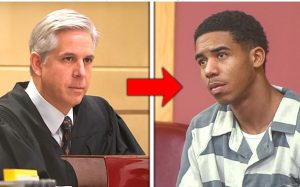The courtroom was silent as Judge Michael Turner adjusted his glasses and looked down at the man standing before him. The defendant, Daniel Brooks, a quiet 28-year-old mechanic, stood with his head lowered, his hands trembling slightly.

For weeks, the city had followed the case closely a robbery gone wrong, an injured officer, and a suspect caught only a few blocks away. The evidence seemed clear: Daniel’s fingerprints were found on the stolen car, and a witness claimed to have seen him running from the scene.
Now, the moment of judgment had come.
“Mr. Brooks,” the judge began solemnly, “the evidence against you is overwhelming. While I sympathize with your situation, the law is the law. You are hereby sentenced to twelve years in prison.”
The sound of the gavel striking echoed through the room. Daniel’s mother, seated in the back row, covered her mouth as tears streamed down her face. Daniel tried to speak, but his lawyer gently placed a hand on his arm, whispering, “We’ll appeal. Don’t lose hope.”
But inside, Daniel felt broken. He knew he was innocent and that somewhere, the real criminal was still free.
A Judge’s Doubt
Days turned into weeks, and Judge Turner went on with other cases. But something about Daniel’s eyes haunted him. They weren’t the eyes of a liar. There was pain there and truth.
One evening, as the judge reviewed old files in his office, he came across a small detail he hadn’t noticed before: a surveillance report from a nearby gas station that was never presented in court. The timestamp showed a man wearing the same jacket as Daniel — but the build looked completely different.
The judge frowned. “Why wasn’t this shown during trial?” he muttered to himself. He decided to make a quiet call to the detective who had handled the case, Officer Miller.
“Miller,” the judge said over the phone, “I need to ask about the Brooks case. Was every piece of evidence reviewed before trial?”
There was a long pause. “Your Honor… there were some technical issues with the video footage. It was blurry. We didn’t think it would help the case.”
But Judge Turner wasn’t satisfied. “Send me everything you have,” he ordered.
A Shocking Discovery
The next day, the judge received the full video file. He watched it several times, adjusting the contrast and brightness. Slowly, the image became clearer — enough to reveal a tattoo on the suspect’s hand.
Daniel Brooks didn’t have any tattoos.
The judge’s pulse quickened. He checked the police report again. The tattoo wasn’t mentioned anywhere.
Something was wrong.
That night, he couldn’t sleep. He replayed the entire trial in his mind the rushed testimonies, the missing details, the pressure from the public to find someone guilty. He realized that everyone, including himself, had been in a hurry to close the case.
The next morning, Judge Turner requested a private meeting with the District Attorney. “I believe an innocent man may be in prison because of our mistake,” he said firmly.
The DA looked surprised. “You’re saying we got it wrong?”
“I’m saying we didn’t look deep enough,” the judge replied. “And I won’t rest until we find the truth.”



